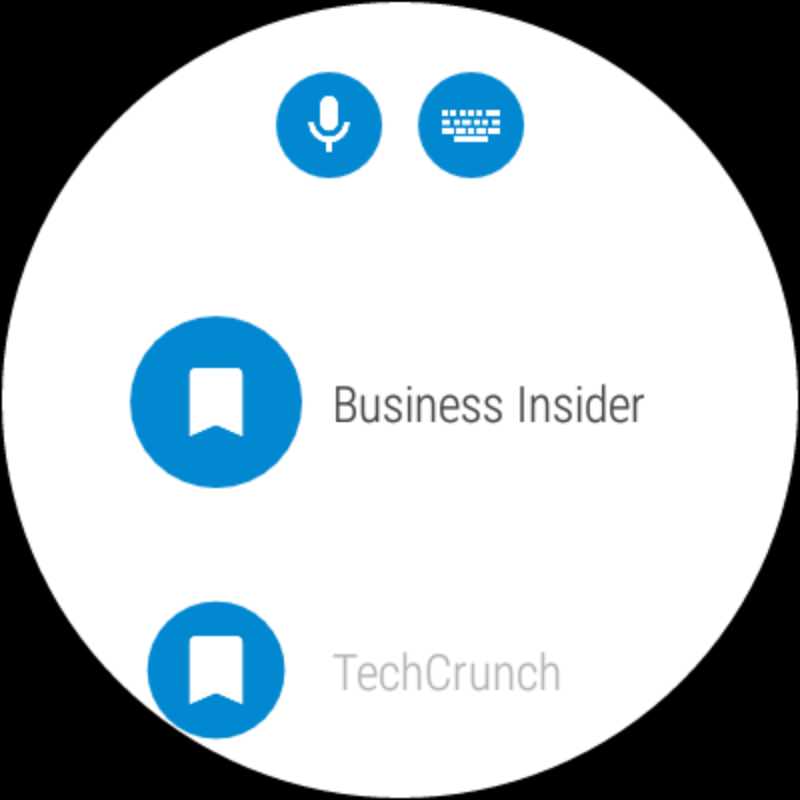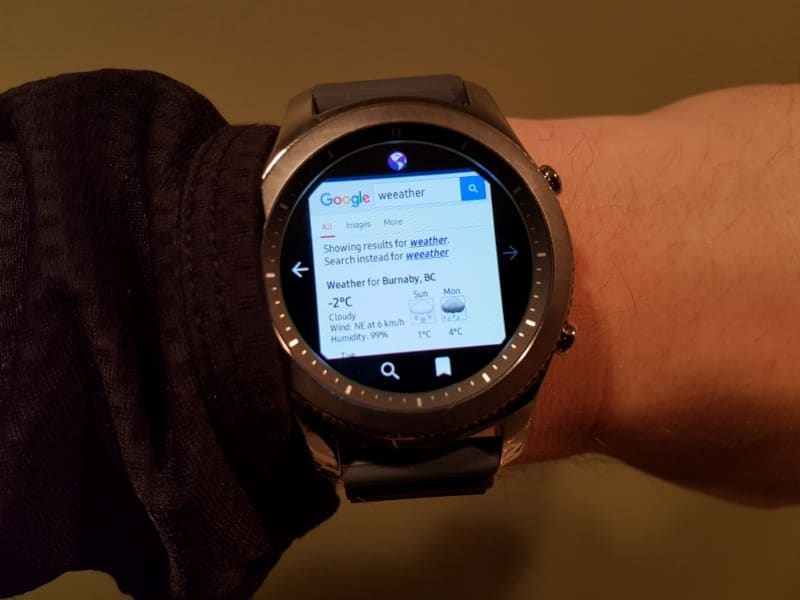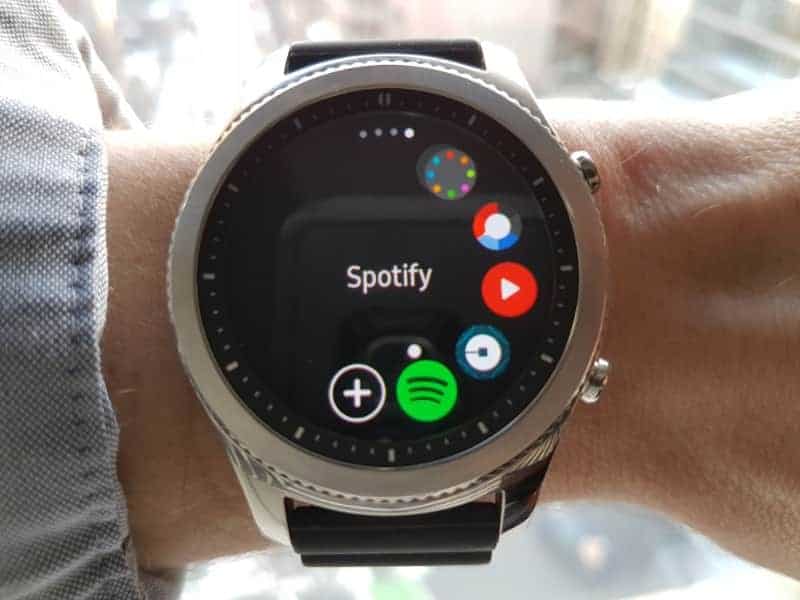You'd do well with the Ticwatch E3 unless you need the advanced sporting features of the Suunto 7.
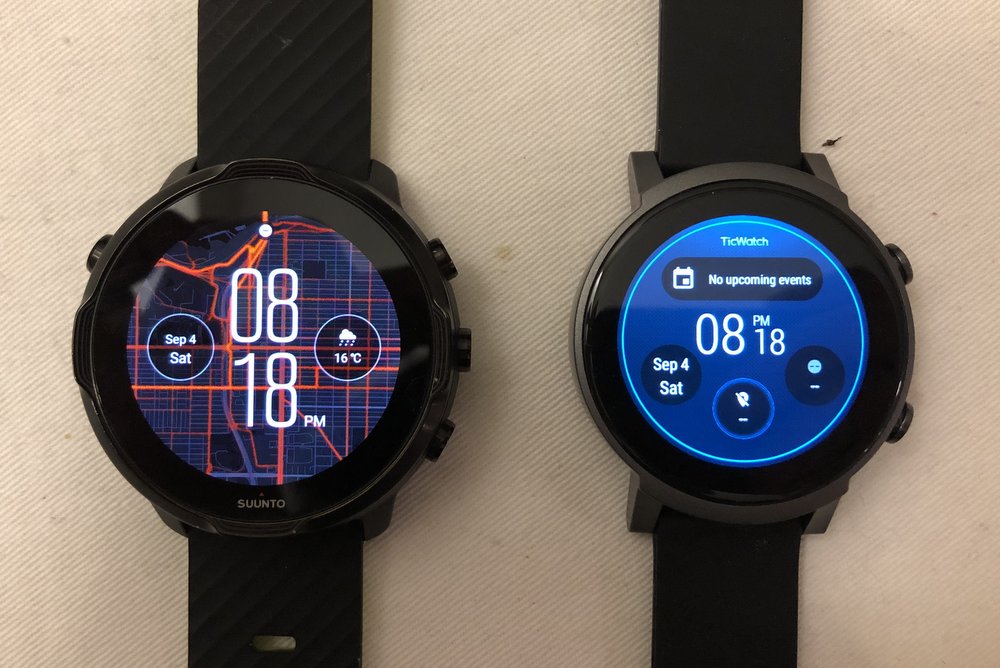
Comparing the Ticwatch E3 vs Suunto 7 is kinda tough. The Ticwatch E3 and the Suunto 7 are very similar…
In fact, the Ticwatch E3 can be considered a successor to the Suunto 7.
Why? Because the software is almost the same. But the hardware on the Ticwatch E3 is the latest and the fastest.
In a sense, the Ticwatch E3 is a typical Wear OS watch. It’s good and it does everything you’d want from a general purpose smartwatch.
However, when you buy a Suunto, you are buying something that is meant for activity tracking. It’s a very special Wear OS device.
It’s not for everyone. It’s meant for the sports enthusiast who wants to collect more data from their exercises.
But you might say, “hey, don’t they both run on Google’s Wear OS? That must mean whatever one can do, the other can too…”
Let’s talk about how a Wear OS smartwatch can differ in the details
Table of Contents
- Hardware
- Wear OS 3 not available on Suunto 7
- Design
- Two buttons vs four buttons
- Voice assistant
- Battery Life
- Phone calls
- Messages, emails
- Maps
- Health features
- Fitness tracking
- Verdict
Hardware
OK, let’s start with hardware.
The Suunto 7 had a really class leading hardware configuration when it was first released.
Unfortunately, as with all tech, it ages and becomes second-rate.
But second-rate doesn’t mean it’s bad. I mean, I’m perfectly happy with an Apple Watch that’s one generation old (kinda also speaks to the lack of new innovation, but I digress).
The Suunto 7’s Qualcomm Snapdragon 3100 might be one generation older than the Snapdragon Wear 4100 available on the Ticwatch E3, but I can’t tell the difference.
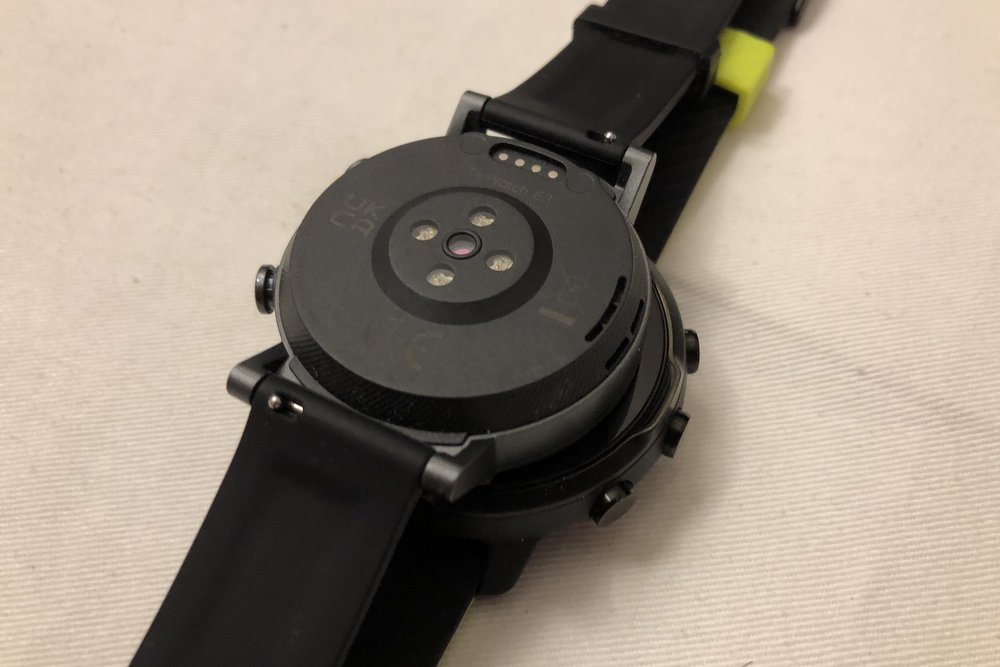
In the bad old days, yes, you could tell the difference between a 3100 and a 2100 (two generations old as compared to the Wear 4100.
For example, activating Google Assistant took forever. And if there were an update running in the background, you’d get nothing done. The watch will be completely hung.
Not on these Mobvoi’s Ticwatch E3 or Suunto’s watch.
To be frank, both feature excellent performance despite the difference in processor.
They both have 1GB RAM so the difference in performance is negligible.
Both smartwatches also have a onboard GPS chip for GPS tracking which is great if you don’t want to bring your phone around as you go exercising.
Wear OS 3 not available on Suunto 7
OK. Imagine if a computer will always be stuck running Windows 10 when Windows 11 is slated to come out (and it’ll be free). Would you buy that computer?
That’s exactly the dilemma you’ll have with the Suunto 7, if you care about this.
Google has confirmed a new and exciting Wear OS 3 that will combine the prowess of a Samsung-Fitbit-Google merger.
You ain’t getting it if you have the Suunto 7 because it seems that you need the Qualcomm Snapdragon Wear 4100 to qualify.
I am not entirely sure what this would mean in terms of features and I am confident the Suunto 7 is a great smartwatch regardless of operating system, but you’ll be left behind really soon.
You won’t have this problem on the Ticwatch E3, though. You’ll breeze ahead and get a free upgrade when the time comes.
Design
The design of the Suunto 7 is a lot less elegant than the Ticwatch E3 in my opinion.
The Ticwatch E3 is slimmer, lighter and certainly more muted in colours (they’re all grey colours).
The Suunto 7 is, on the other hand, still very light, but it is thicker and a bit larger.
Two buttons vs four buttons
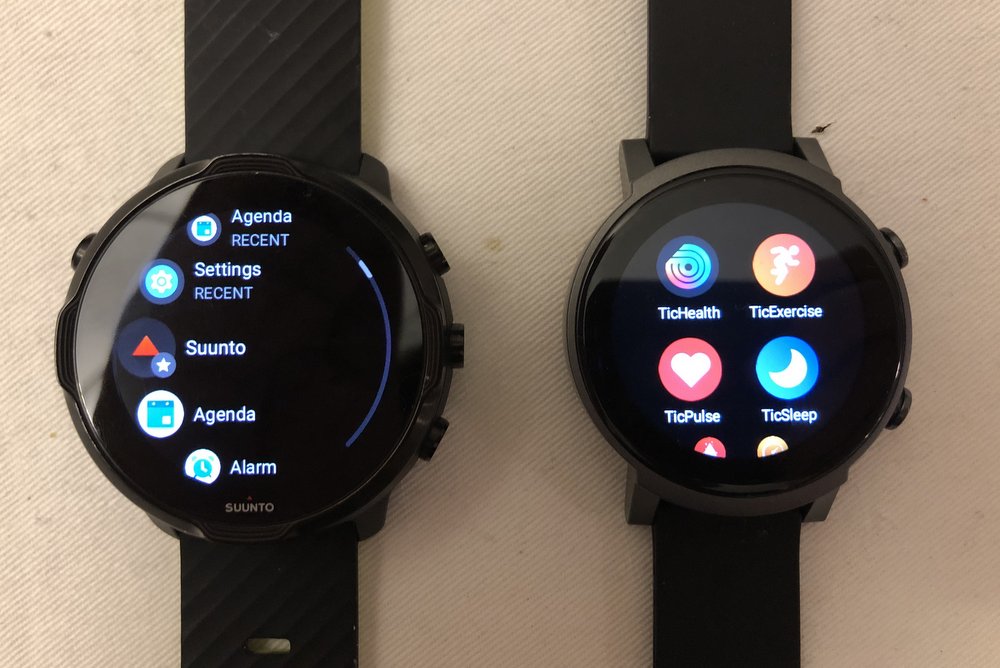
The Ticwatch E3 has two buttons on the watch case’s side whereas the Suunto 7 has four buttons.
I liken it to my good old 2010 model year car and a 2020 model year car.
On the 2010, all the radio controls are done through tactile buttons. One button, one function.
On the 2020 model year car, the radio is controlled by a tablet. One area of the screen can have multiple functions. Even changing the volume requires you to LOOK at the screen.
It’s the same deal here with the Ticwatch E3 (the equivalent of the 2020 model year car) and the Suunto 7.
Having four buttons is great because you’ll know exactly what you’re doing. I know I am activating the sports tracking mode by pressing a button or activating music controls or skipping a track.
The two buttons on the Ticwatch E3 is basically only one customizable button and it defaults to the fitness tracker app.
On both watches, one button is reserved as the home button, much like an iPhone’s only button.
Voice assistant
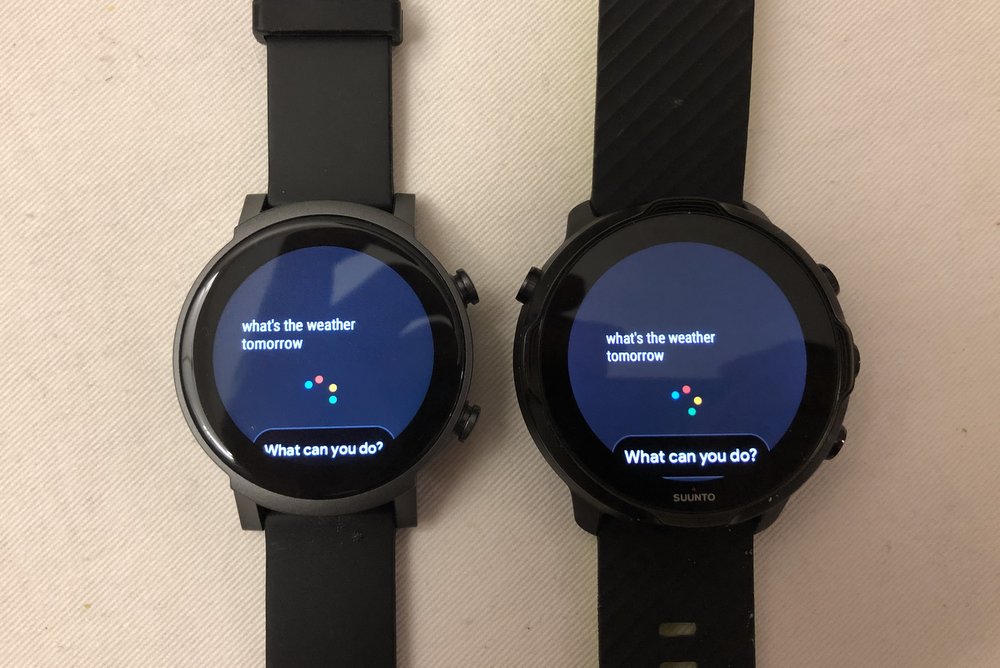
Both of them have Google Assistant and that’s great.
Google Assistant has to be the best voice assistant outside of Siri that you can only get on an Apple Watch Series smartwatch.
It’s great because you can ask it any question and half of the time it’ll give you something useful… or it’ll search the web to answer your query.
That’s kinda important to me because I really dislike swiping on a small screen while lifting my arm. It gets tiring and tedious.
Instead, I want a smartwatch to be able to receive my voice input and start timers for me. Or something tedious.
I am glad to report both of them do it very well.
Battery Life
Battery life of both smartwatches are about the same in that you can expect to charge them daily.
You might be able to eke out a second day but only if you’re really disciplined with avoiding using a lot of functions including handling smartphone notifications.
Phone calls
You can’t make phone calls on the Suunto 7. It doesn’t have a speaker.
Whereas on the Ticwatch E3, you have the ability to make and receive calls.
It’s pretty amazing that the Ticwatch E3 has a similar feature set as its higher-end Ticwatch Pro brothers.
I have always found that the Ticwatch E3 is going to undercut Mobvoi Ticwatch Pro’s profits because it can offer almost all of its features except the dual layer screen.
Messages, emails
You can get messages and emails through your notifications on the Ticwatch E3 and the Suunto 7.
All Wear OS smartwatches have a microphone which is very important for helping you reply easily.
I pretty much only use the speech to text function to reply. It’s great.
Maps
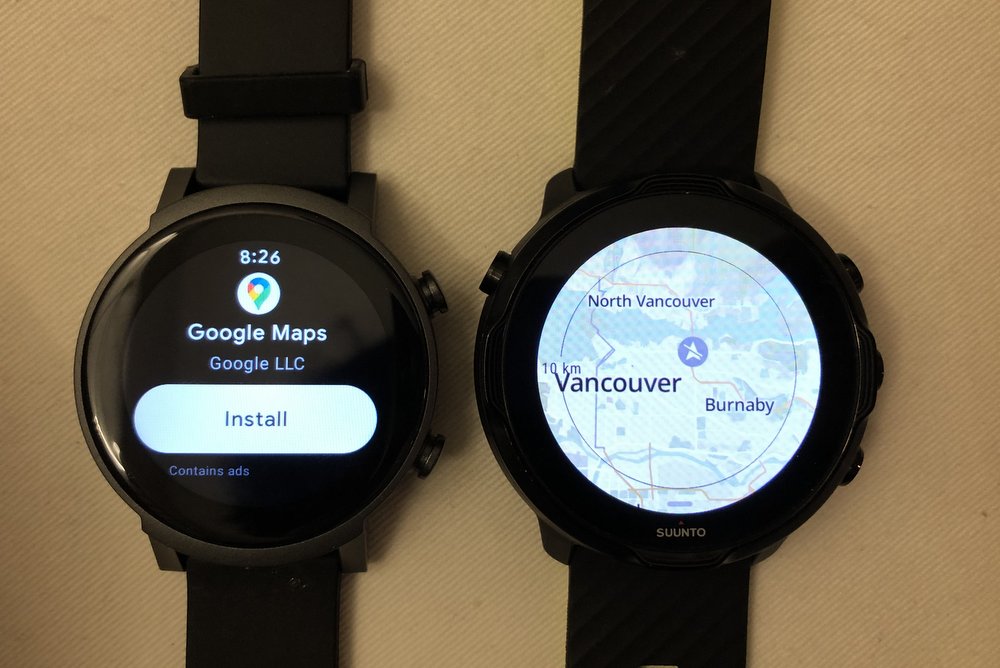
One of the biggest selling point are the integrated and offline maps on the Suunto 7, which is also one of the most valuable smartwatch features out there for sports enthusiasts.
The main reason why I am such a fan of this feature is that it really helps you navigate areas that are unfamiliar to you.
Now, you could say that the Ticwatch E3 has a similar feature in that you can download the Google Maps Wear OS app, but the main difference here is that the Suunto’s maps are offline maps.
That means you don’t need a data connection for it to work and honestly, when you are deep in the woods or out at sea, that makes all the difference because you aren’t going to have LTE connectivity.
Health features

The main reason why you’d buy the Suunto is for its sport features.
But the Ticwatch E3 has a few other advantages in terms of health tracking features.
If you flip both watches over, you’ll find that the Ticwatch E3 has the most vaunted feature of 2020 — the SpO2 sensor (also known as a pulse oximeter). This is integrated with the heart rate monitor sensor.
What that does is that it monitors blood oxygen saturation. It’s now on every modern smartwatch out there.
I truly have no idea what this measurement is for. Really… if I get a low reading, I’ll not have a clue was to what to do with this information.
But it’s there and perhaps someone will have a use for it.
Now, I also suggested above that both smartwatches have a heart rate monitoring feature. It’s pretty standard these days.
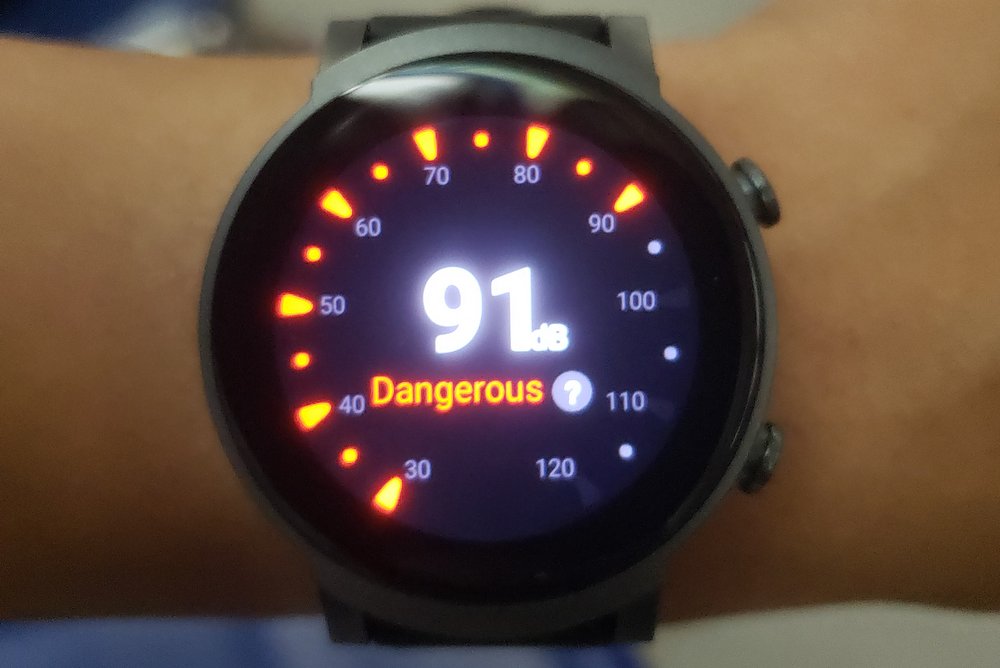
Anyway, the Ticwatch E3 offers much more than just SpO2 readings. You can also get a reading on environmental noise through the TicHearing app as you can get your stress levels through the TicZen app.
The implementation for both apps isn’t ideal because they aren’t passive apps. On the Apple Watch Series 6, for example, ambient noise is tracked all the time so it’ll notify you if you are in a very noisy environment. Whereas on the Ticwatch E3, you’d have to open the app before you can get a sense of how noisy your environment is.
Both watches also have sleep tracking. It’s a bit more comfortable to sleep while wearing the Ticwatch E3 but the Suunto 7 isn’t far off in comfort.
Fitness tracking
Fitness tracking is the mainstay of the Suunto app’s reason for exisiting.
It’s excellent. You get so much information from it.
The only watch that can do it better is the Garmin Fenix.
The Suunto app on the smartwatch has a ton of sport mode from the standard run, bike and swim to much more obscure modes such as motorsports, roller skating (or roller skiing), cross country skiing and canoeing.
Contrast that to the Ticwatch E3 and you’ll find that the Ticwatch E3 doesn’t compare very well.
Ticwatch E3 tries very hard to get you to use the TicExercise app that Mobvoi makes.
The app is OK. It doesn’t suck.
But compared to the number of choices you have for workouts that you can track, you’re going to be a lot better off with the Suunto 7 if you like sports that are “edgy” or just a little less common.
The data that TicExercise tracks is also much more typical such as speed, distance and heart rate.
On the other hand, the Suunto 7 can give you advice about your workouts. It can tell you about the intensity of your workout, how much recovery time you should factor in and whether you are doing the right amount of training.
Verdict

Meh, you’ll do well with both watches.
But you’ll do better with the Ticwatch E3 if you don’t need all the fancy sport features.
The Ticwatch E3, despite its more affordable price, has some of the best features out there for its price.
It even has some features that the Suunto 7 doesn’t have. That’s pretty amazing value.

